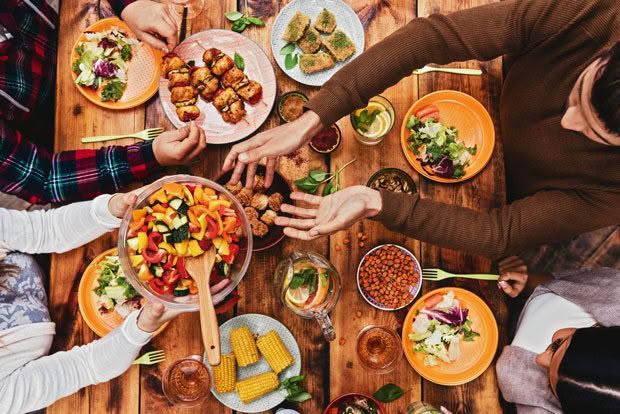Dr Libby’s guide to eating ‘flexitarian’

Force yourself to eat a certain way and you will likely fail. try giving yourself a little wiggle room instead.

Words: Dr Libby Weaver BHSci (N&D) (Hons) PhD
Question: There’s a lot of confusion in the media about the best eating plan to follow. What are your thoughts on this?
There seems to be a name for every way of eating. Your diet might be described as vegetarian or vegan or – even more specifically – lacto-ovo-vegetarian, pescatarian or paleo. But while it’s fantastic when people take an active interest in their well-being, the labels usually come with strict rules and are often unsustainable unless followed with deep commitment.
A set of criteria concerning what’s acceptable and what’s not can help some to stay focused. But it may be completely off the mark for others, setting them up for feeling as if they have failed if it doesn’t have the desired effect, or they can’t stick to it. When someone else has told you to eat in a certain way, you are less likely to commit to it than if the choice arose from your own desire to care for yourself and/or the planet. If you need a label for how you eat try “flexitarian” or “qualitarian” and embrace the traits these names suggest.

GET CONNECTED
The concept of being a flexitarian is about listening to what will best serve your body, health, energy and even your spiritual practice. When you are hungry you have an awareness of what will best serve your needs and you subsequently choose this. (Note: this doesn’t mean that taste buds rule the decision-making. It is about being in touch with what your body wants for its best nourishment.) Anyone can adopt the principles of being a flexitarian and it simply means you don’t have stringent rules. It means that most of the time you make nutrient-dense food choices, yet if you catch up with your best friend on a Friday night and eat takeaways you don’t beat yourself up for a less nourishing choice, nor does it mean you eat fast food every night for the next week.
When approaching nourishment, a flexitarian may just hold to the idea of having high standards. In other words, you choose not to eat that highly processed, sugar and preservative-laden snack not because someone told you not to but because it doesn’t serve your health, quality of life or your longevity.
That same flexitarian may also choose to approach celebrations and special occasions with a more relaxed attitude, understanding it’s what we do every day, not occasionally, that impacts our health. Feeling guilty about the odd poor-quality food choice does nothing for your health either.
A MEAL AT A TIME
Another example would be to adopt a “zig and zag” approach. A zig meal is made up of nutrient-dense foods, real foods and no alcohol. While for a zag meal, the focus is more about the company you are in, being playful and relaxing.
Zags are part of a healthy and sustainable lifestyle and might occur once or twice a week. If you eat 21 times a week, one to two zags is a small percentage of poorer quality food.
It can also be helpful to look at the overall dietary principles that serve most of us – these include eating plenty of vegetables, a little fruit, small amounts of lean animal protein (if desired) or plant protein and minimizing (or omitting) consumption of refined carbohydrates and sugars. While there are certainly conflicting opinions on the best way to nourish yourself, there is unanimous agreement that we can all benefit by eating more – and a greater variety of – vegetables.

Eat processed meats such as bacon in moderation.
WHAT ABOUT MEAT?
It’s also certainly important for meat eaters to consider how often they consume meat, the quality of this meat, what the animals have been fed and how they have been raised. Over the past decade there has been a dramatic increase in the prevalence of cheap and poor-quality meat options – there is a big difference nutritionally between organic, grass-fed meat and $3 sausages.
Many of us could benefit from decreasing our consumption of meat, specifically processed foods such as bacon, ham, salami and sausages, which are not only high in sodium but also tend to contain preservatives and additives, sodium nitrate being one of the most common. Sodium and nitrite themselves are not carcinogenic, but nitrite formed from dietary nitrate has been shown to react with dietary amines to form carcinogenic nitrosamines, so it’s certainly important to limit your consumption of this preservative.

LISTEN TO YOURSELF
Food is designed to energize and if you regularly notice that what you’ve eaten makes you feel tired then reflect on the aspect of that meal which may have caused it. Or seek the help of an experienced health professional to guide you. Our body doesn’t have a voice but it regularly gives us feedback, suggesting that we eat, drink, move, think, breathe, believe, or perceive in a new way. So see these “messengers” as the gifts that they are. We can learn, grow and contribute from such a process of enquiry.
For those of you who are energized and uplifted by strict rules or have an illness that requires you to eat exceptionally all the time, please continue to do that. You know if this is you. If, however, you are someone who fears food, weight gain or uses food as a mechanism of control in your life, or holds tightly to “control” in general, then you might want to consider relaxing a little. Rigidity that stems from fear doesn’t serve the health in any way.
 This article first appeared in NZ Life & Leisure Magazine.
This article first appeared in NZ Life & Leisure Magazine.
